The Beginner's Guide To Flying RC Airplanes e-book
In this crazy world we live in right now, a new absorbing hobby is the perfect antidote!
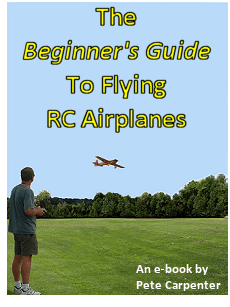 Without question, the radio control flying hobby has to be one of the most exhilarating, addictive, fulfilling and rewarding pastimes you can have. I can personally assure that, from years of aeromodelling experience.
Without question, the radio control flying hobby has to be one of the most exhilarating, addictive, fulfilling and rewarding pastimes you can have. I can personally assure that, from years of aeromodelling experience.
So to give you a rock-solid start to your new hobby, my Beginner's Guide To Flying RC Airplanes ebook is packed with concise, easy to digest information guaranteed to save you valuable time, money and trouble. Guaranteed.
Why Buy this Ebook?
Because at only $10, it's a very small price to pay for learning how not to crash your new plane on its first flight!![]()
Truthfully, if you want to fly rc planes a solid understanding of your new hobby is what you need.
As a newcomer to this fantastic and hugely popular pastime, The Beginner's Guide To Flying RC Airplanes won't overload you with all the unnecessary stuff that you don't need to know right now. It gets right to the point and answers all the 'getting started' questions that you're ever likely to have.
The ebook can be purchased securely through PayPal (no account needed) and downloaded in just a few clicks, by using the 'Buy Now' buttons on this page.
- Norm H., USA.
|

|
Purchasing problems? Please let me know.
Ebook Topics Include...
- Understanding RC systems & how they control your plane.
- What you need to know when choosing your first plane.
- Preparing your plane for flight.
- Finding somewhere suitable to fly.
- The essential pre-flight checks you need to know.
- Complete flight school to get you airborne safely (take-offs, flying & landing).
- How to fly some basic aerobatics.
- How to deal with a crash.
- ...and more!
What's in The Beginner's Guide To Flying RC Airplanes?
Below are some page excerpts from the e-book:
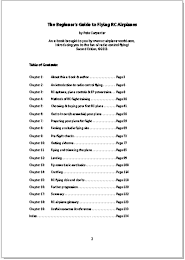
Chapter 1: An introduction to your new hobby
Chapter 2: R/C systems, plane controls & EP powertrains
Chapter 3: Methods of R/C flight training
Chapter 4: Choosing & buying your first RC plane
Chapter 5: Get to know (& assemble) your plane
Chapter 6: Preparing your plane for flight
Chapter 7: Finding a suitable flying site
Chapter 8: Pre-flight checks
Chapter 9: Getting airborne
Chapter 10: Flying and trimming the plane
Chapter 11: Landing
Chapter 12: Fly some basic aerobatics
Chapter 13: Crashing
Chapter 14: RC flying do's and don'ts
Chapter 15: Further progression & summary
Chapter 16: RC airplane glossary
Chapter 17: Useful resources & references
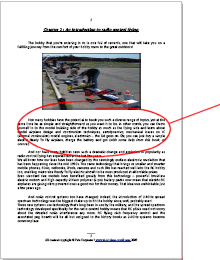
"Not many hobbies have the potential to teach you such a diverse range of topics, or at the same time be as simple and straightforward as you want it to be.
In other words, you can throw yourself into the model building side of the hobby as much as the flying side of it, and learn about model airplane design and construction techniques, aerodynamics, mechanical issues, model engines, electronics.... the list goes on.
Or you can just buy a simple electric Ready To Fly airplane, charge the battery and go!"
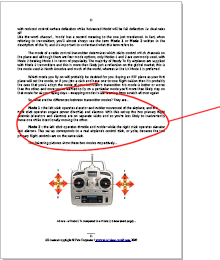
"So then, what are the differences between transmitter modes? They are....
Mode 1 : the left stick operates elevator and rudder movement of the airplane, and the right stick operates engine power (throttle) and ailerons. With this set-up the two primary flight controls (elevators and ailerons) are on separate sticks and so you're less likely to inadvertently move one while intentionally moving the other.
Mode 2 : the left stick operates throttle and rudder while the right stick operates elevator and ailerons. This set-up corresponds to a real airplane's control stick, or yoke, because the two primary flight controls are on the same stick.
Personally I fail to see the relevance of this argument though, because flying a radio control plane and a real one are two completely different things anyway, and as someone who flies RC planes and has held a Private Pilot's Licence and flown full size planes, I know just how very different they are...."
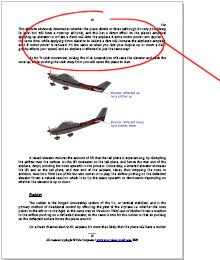
"Elevators are the most important of all control surfaces, and as a result of the nose-up/nose-down attitude of the plane they directly effect a plane's airspeed. Up elevator will reduce the speed if engine power is not applied at the same time, while down elevator will initiate a dive and hence the airspeed will increase, as gravity kicks in.
So don't just see the elevators as the things that make the plane point up or down - they really are more than that! The illustration below shows the effect of elevators on the plane's pitch attitude.
As for transmitter stick movement, pulling the stick towards you will raise the elevator and pitch the nose up, while pushing the stick away from you will drop the elevator and cause the plane to dive."
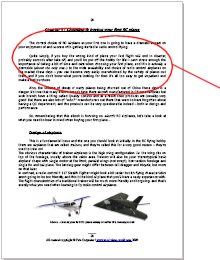
"The correct choice of RC airplane as your first one is going to have a big impact on your enjoyment of and success with getting started in radio control flying.
Quite simply, if you buy the wrong kind of plane your first flight will likely end in disaster, probably seconds after take off, and you'll possibly lose all interest. I can't stress enough the importance of taking a bit of time and care when choosing your first plane, and this is actually a downside (about the only one...) to the wide availability and choice of radio control airplanes on the market these days - you can become very easily overwhelmed by the variety of planes out there, and if you don't know what you're looking for then it's all too easy to get impatient and make a bad purchase."
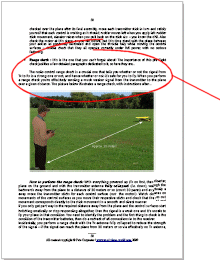
"The radio control range check is a crucial one that tells you whether or not the signal from Tx to Rx is good, and hence whether or not it's safe for you to fly your plane.
When you perform a range check you're effectively sending a much weaker signal from the transmitter to the receiver over a given distance. The picture below illustrates a range check, with instructions after...."
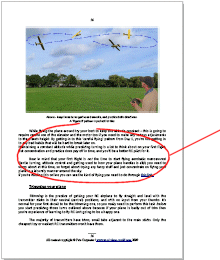
"If your plane has ailerons, use these in conjunction with up elevator to turn. Apply aileron and elevator to turn, and then opposite aileron to finish the turn and level the wings. You probably won't need much up elevator at all throughout the turn, but this is going to depend on the plane that you have. Return elevator to neutral as you exit the turn, or as necessary to maintain a constant height.
If you are using ailerons on a four channel plane, don't worry about rudder for now. Use of rudder will come with time."
As the samples above briefly show, each page takes you step-by-step all the way.
- Noel B, Australia.
Why buy The Beginner's Guide To Flying RC Airplanes?
Quite simply, because it's a damn good book - even if I say so myself![]()
I've been helping people get in to radio control flying, via this website and my forum, for over twenty years now. I'm passionate about it, and I love it.
The ebook is a natural extension of my website, and over 4000 copies have sold to date - and I've had one person say that it didn't help them. I can live with that!
Testimonials
Whether you're a believer in testimonials or not, here are some nice words that readers have actually sent me after reading the ebook:
"If your plane is heading towards Mother Earth unintentionally, the other thing to remember is not to panic. Panicking really doesn't help the situation at all, if anything it will just make things worse than they already are, as your nerves get the better of you. And after your plane has impacted the ground, don't despair or break down crying! Take a few moments to gather your thoughts about what possibly went wrong, then start the ceremonial and embarrassing Walk of Shame over to the impact zone to collect the wreckage. It's never a nice task, but it has to be done!"...
Beautifully crafted! Thanks for a great read. Best regards, David H.
- Lee C, USA.
- Albert S., USA.
- Tom G., USA.
- Adrian B, Spain.
- Jim B., USA.
- Andrew L., USA.
- Tuanwah, Singapore.
- Dave B., Australia.
- John S., Canada (rchelicopterfun.com).
- Colin D., UK.
- Jack., USA.
Important Purchasing Info
Please be clear that "The Beginner's Guide To Flying RC Airplanes" is an ebook, not a hard copy book. In other words, it's a PDF file that you download and save to your computer.
Most computers/devices already have a PDF reader installed, but if not then Adobe Reader is a popular one which you can get for free from here.
When you buy the ebook, you'll receive an automatic e-mail from pete. carpenter 12 @ gmail . com (no spaces) which contains a link to the download page.
If there are any issues with your download, or you don't receive the download email, please contact me and I'll sort it. I can either get the download email resent, or I can send the ebook through to you as an email attachment.
- Jeff P., USA.
|

|
Purchasing problems? Please let me know.
The RC Beginner's Guides E-book Combo - Save $$!
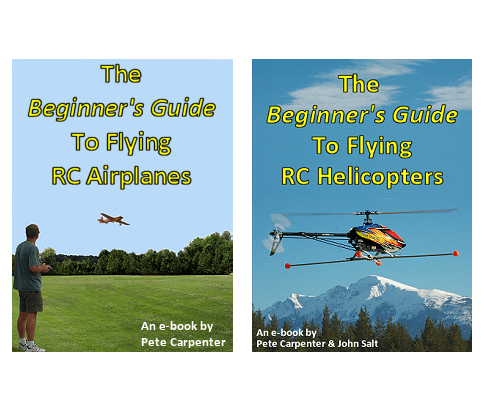
Why fly one aircraft type when you can fly two?!
Many of us like the idea of flying rc airplanes and helicopters. If you want to know about learning to fly both types of radio controlled aircraft, you can purchase The Beginner's Guide To Flying RC Airplanes and The Beginner's Guide To Flying RC Helicopters ebooks together and save some valuable dollars. The cost for this deal is just US$29.95 - truly fantastic value for so much info.
You can get the ebook combo deal here.
Both guides follow the same easy-reading format and style, and contain equal amounts of essential information to get you started safely in this perfect pastime.
Refunds
The Beginner's Guide To Flying RC Airplanes ebook is a very genuine and original resource for anyone looking at getting in to flying radio control planes.
If, after you've read it, you're dissatisfied with the information contained within it please e-mail me and I will sort out a refund.
Please don't ask for a refund if you thought you were buying a hard copy book but then downloaded the ebook. I cannot make it any clearer throughout this page that this product is an ebook and not a hard copy book!
To buy The Beginner's Guide To Flying RC Airplanes right now, just use the 'Buy Now' button below and download your ebook in just a few minutes.
Payment is safe and secure, through PayPal.
- Greg, USA.
|

|
Purchasing problems? Please let me know.
Related Pages
![]() The Beginner's Guide To Flying RC Helicopters.
The Beginner's Guide To Flying RC Helicopters.

